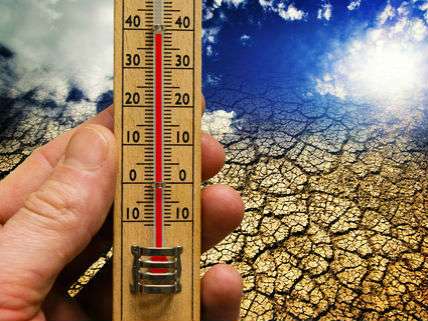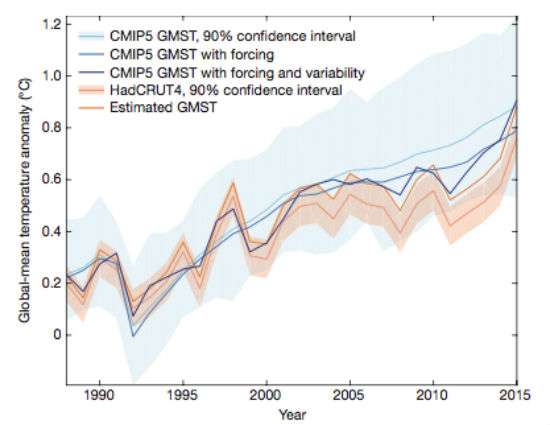Climate Computer Models Right After All: What Global Warming Hiatus?
Does new study reconcile controversies about the 'global warming hiatus'?

"We are now much more confident than ever that human influence is dominant in long-term warming," declares a team of climate researchers from the Swiss Federal Institute of Technology led by Iselin Medhaug. Why? Because, among other things, they claim to have reconciled the differences between the computer model projections and observational temperature records. The article, "Reconciling controversies about the 'global warming hiatus'" appears today in Nature.
First they note that there are definitional problems in the scientific literature. The global warming hiatus can describe the period between 1998 and 2015 in which there was (1) no discernible increase in global average temperature, (2) a dramatic slow-down in the increase warming from the prior late 20th century trend, and (3) a slower increase than projected by climate computer models. They also explore the proposed causes for the hiatus including external drivers such as solar variability and aerosols from volcanic eruptions; the possibility of a lower equilibrium climate sensitivity in response to added carbon dioxide; and internal variability, especially periodic long-term shifts in regional ocean temperatures.
Another important concern is how the observational temperature records are measured and adjusted over time. For example, the U.K.'s Met Office's HadCRUT4 surface temperature data set was adjusted to take into account that the Met Office's previous datasets had used sea surface temperatures rather than air temperature measurements over the oceans. Overall, this adjustment resulted in higher global mean surface air temperatures. They also took note of the fact that the observational temperature records have poor coverage in remote areas like the poles, central Asia, and central Africa. Interestingly, the researchers used observational surface temperature datasets in their analysis, ignoring the satellite and weather balloon temperature datasets.
Medhaug and his colleagues adjusted the computer climate model runs by taking into account factors like changes like variations in solar radiation. In addtion, they applied results from computer models that best mimicked the observed internal variability of ocean temperature changes to estimate their effects on global air temperature to update the overall projected model trends. They do reanalysis of the HadCRUT4 dataset using model outputs to estimate temperatures in regions that are not adequately covered by observations. This produces a new dataset with higher global average temperatures.
They then compare the results of 84 simulations from 36 different climate models with the orginal HadCRUT4 and their adjusted HadCRUT4 data. Once the researcher make all of these adjustments they find that there is …
… excellent agreement between models and observations (Fig. 5, dark blue versus dark orange lines).

Most discrepancies between models and observations can therefore be explained by the state of the natural variability, incomplete or biased forcings, and observational limitations; a complete explanation requires a combination of all of these (Fig. 5). When the effects of short-term temperature variations such as the El Nin?o Southern Oscillation (ENSO), of volcanic aerosols and of solar variability are removed, the anthropogenically forced global warming signal has not decreased substantially. This supports the current scientific understanding that long-term global warming is extremely likely to be of anthropogenic origin.
One point that the Swiss researchers stress is that climate models cannot and should not be expected to make projections encompassing relatively short periods such as a decade. Consequently, they argue that when climate variability from whatever source slows (or presumably) speeds up the rate of increasing temperatures due to man-made global warming that does not invalidate model projections of where average temperatures will be by the end of this century.
These researchers do acknowledge that the apparent hiatus spurred a lot of useful scientific work on measuring ocean temperatures, attempts to take into account missing surface temperature data in remote areas, further efforts to nail down more precisely how the earth's atmosphere will respond to added carbon dioxide, and improvements in the climate models.
Basically, the researchers reconciled the hiatus controversy by lowering modeled temperature trends while raising the observational temperature trend. This is fascinating work and it will be interesting to see how it stands up to the test of time and data.



Show Comments (131)